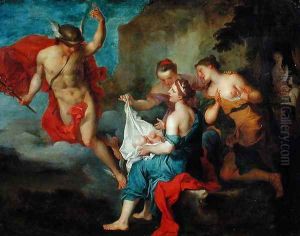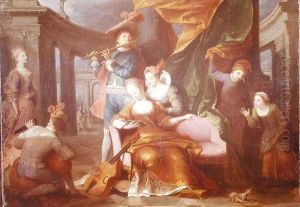Jacques Francois Courtin Paintings
Jacques Francois Courtin was a French painter and engraver whose work is emblematic of the Rococo style, flourishing in the late 17th and early 18th centuries. Born in 1672, his contributions to art are often characterized by their delicate forms, light colors, and playful themes, reflecting the frivolous and optimistic spirit of his time. Courtin's artistic journey began under the tutelage of notable masters, and he quickly established himself as a skilled painter and engraver, adept at capturing the whimsicality of the Rococo movement.
Throughout his career, Courtin was known for his landscapes and genre scenes, which were populated with figures engaged in everyday activities, imbued with a sense of elegance and charm. His engravings, on the other hand, were meticulous and detailed, demonstrating his mastery over the medium. Courtin's ability to blend realism with the ornate and decorative elements of Rococo made his works popular among the French aristocracy and art collectors of the period.
Despite his success, Jacques Francois Courtin remains a somewhat obscure figure in art history, overshadowed by his contemporaries like Antoine Watteau and François Boucher, who are often credited with defining the Rococo style. However, Courtin's contributions to the development of French art during the early 18th century cannot be understated. His works offer a glimpse into the social and cultural dynamics of his time, showcasing the leisure and luxury that were prevalent among the upper echelons of society.
Courtin's legacy, though not as widely recognized as that of his peers, is preserved in the collections of several European museums and galleries, where his paintings and engravings continue to be appreciated for their beauty and historical value. He passed away in 1752, leaving behind a body of work that, while reflective of its time, continues to enchant and engage audiences with its elegance and wit.

